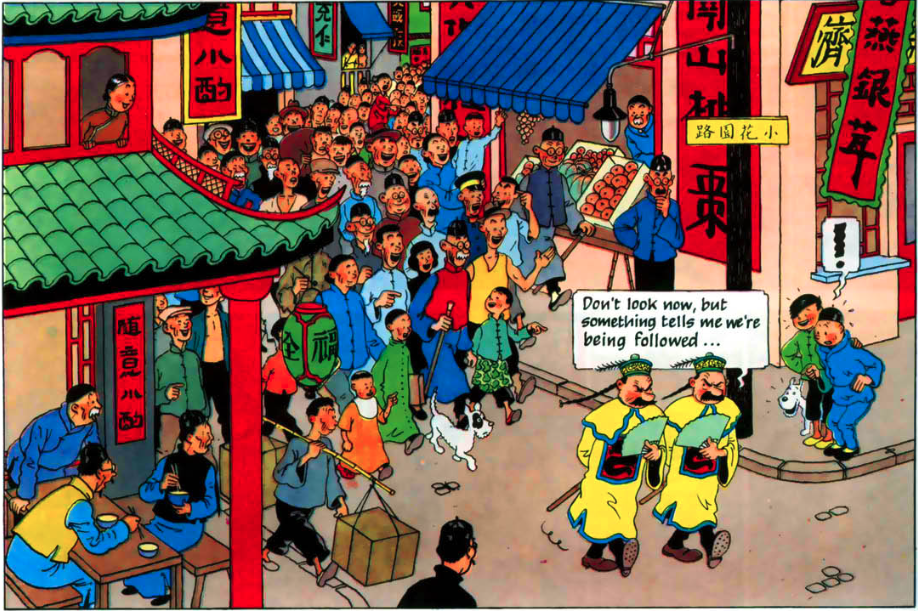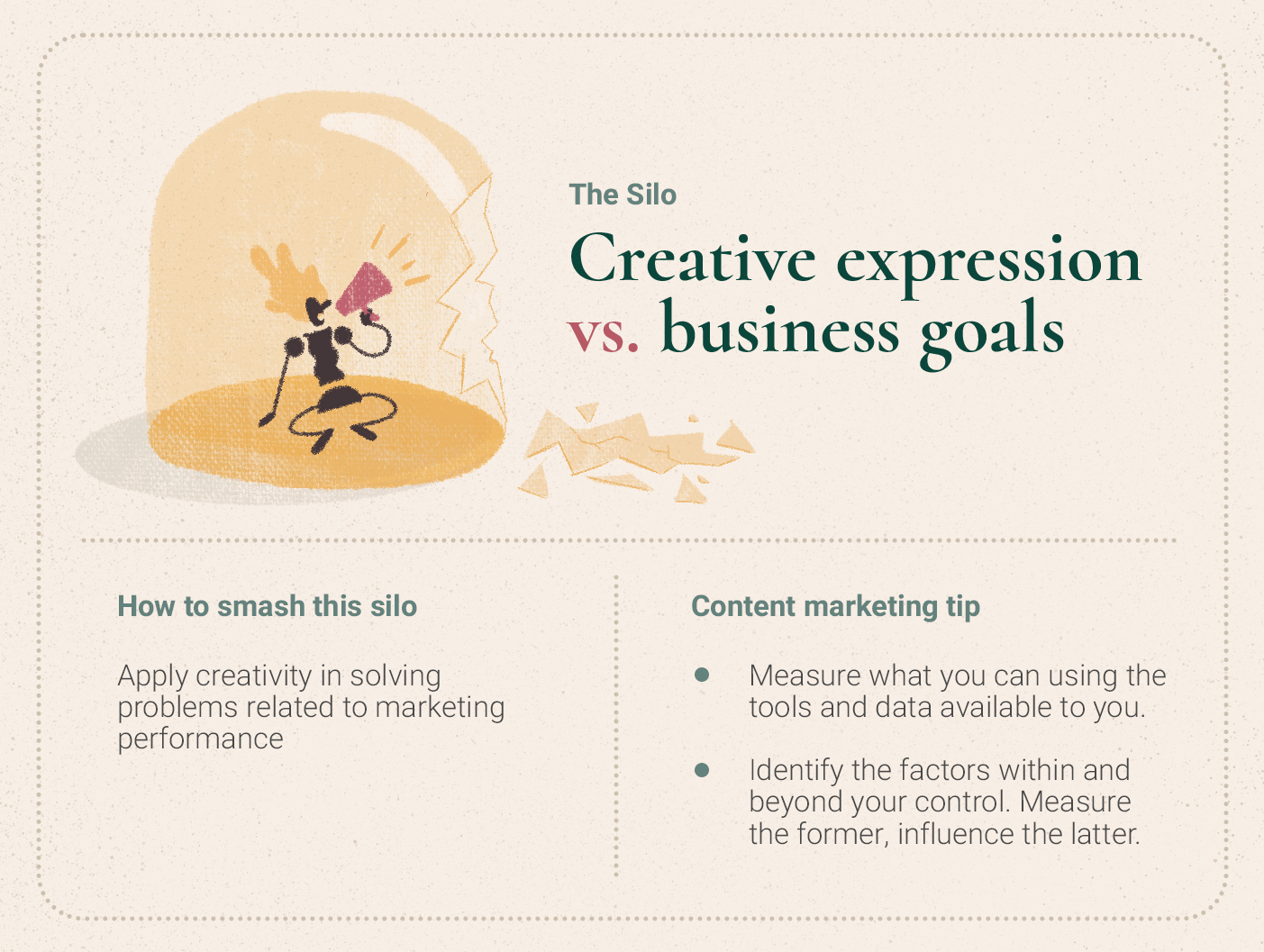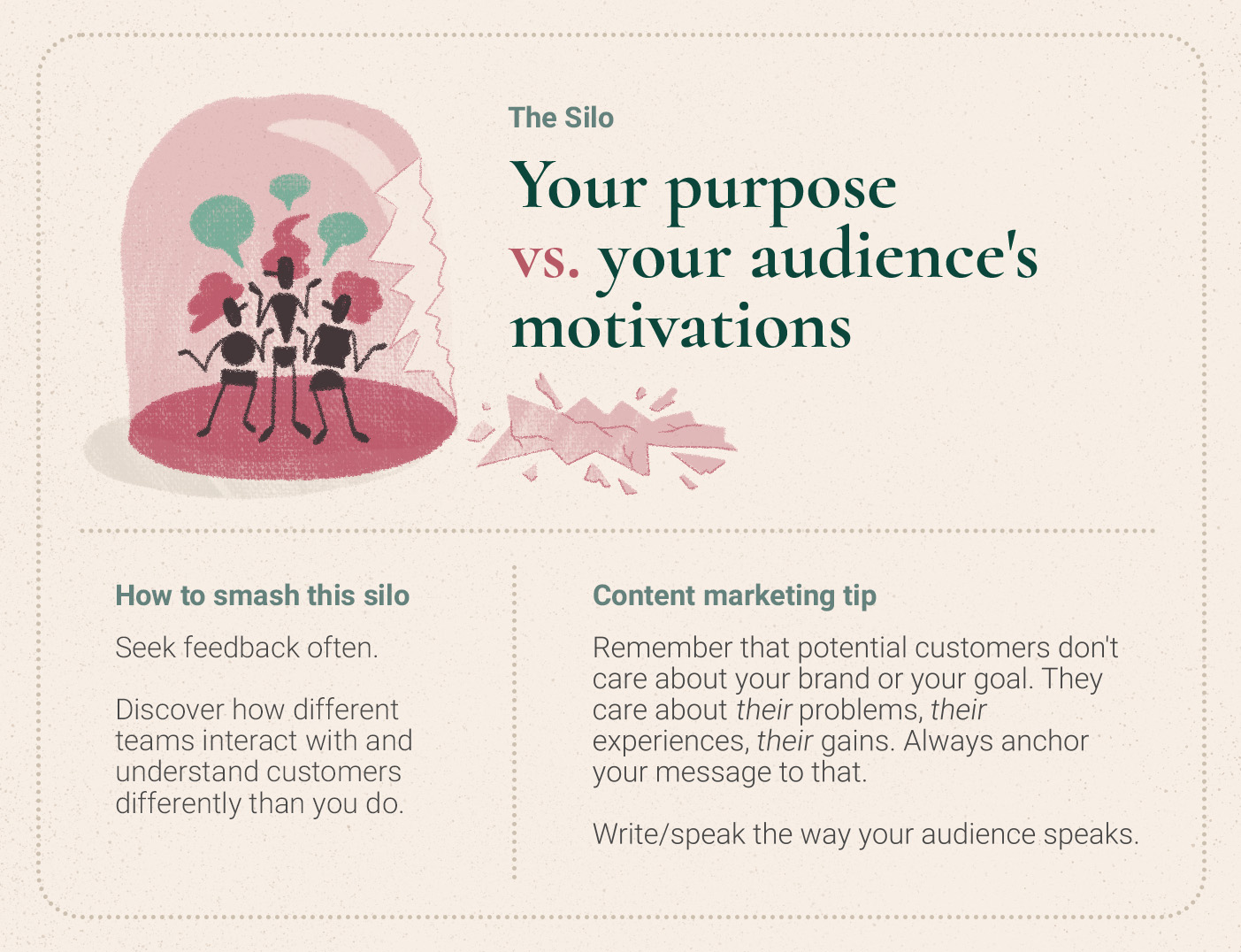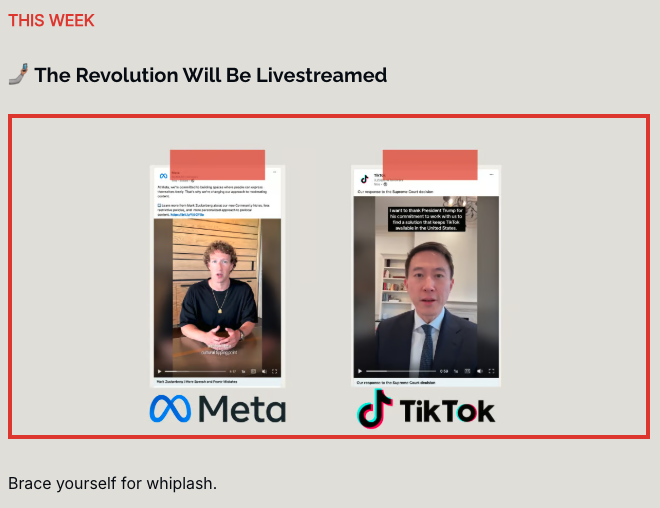
Two European detectives walk down a street in Hukou County, China. A crowd follows them, pointing and laughing and heckling.
The detectives are dressed in bright yellow robes, boat-shaped hats, and long braids. They had donned traditional scholarly costumes, assuming all people in China wore them too.
This is a scene from Blue Lotus, the fifth volume of The Adventures of TinTin comic series. Blue Lotus marked a turning point for the series’ author, Hergé, who for the first time ditched offensive stereotypes of non-Europeans after Chinese students in Belgium enlightened him about their people’s real lifestyles, art, and beliefs.
With his siloes broken down, Hergé created more realistic characters grounded on research. Blue Lotus became known as his first masterpiece and TinTin gained global fame.

A panel from Blue Lotus, part of The Adventures of Tintin by Belgian cartoonist Hergé
This shift in perspective is one of the reasons why Imran Khan, a content marketer-turned-educator, likes the series so much. Imran has a strong CV: he worked at Bytedance, Google, and Tech in Asia (TiA). And now he’s striking out on his own, teaching workshops in critical thinking and creative problem-solving through his venture, Ishara.

We chatted with Imran to learn the best content marketing lessons he has gleaned throughout his career. His stories reflect the siloes many marketers face day to day — and how he broke them down to do effective, meaningful work.
Silo #1: Creative expression vs. business goals

All writers and artists who “fall into” marketing roles experience the tension between creative freedom and revenue goals.
But that’s because we tend to have a limited view of what creativity really is, says Imran. It’s not all about artistic expression — creativity is crucial for solving business problems, too.
“Sometimes we tend to limit the discussion on creativity on branding ideas. The reality is it’s a tough economy. Everyone is looking at how to cut costs. And if a piece of work or an exercise does not have a legitimate ROI to it, or at least a timeline by which a return should be visible, it won’t get approved,” says Imran.
But the space for creativity in B2B marketing is broader than one might think.
“For B2B marketers in Southeast Asia, creativity will be required for all aspects of marketing, from identifying your target audience to reaching them effectively, and measuring the results,” he says.
This holds true for marketers who have difficulties proving content marketing effectiveness, especially those who lack sophisticated analytics tools. Imran’s advice is to simply measure what you can. (We agree — at With Content, we believe content marketers should own the narrative on content marketing ROI by focusing on the factors and metrics they can influence, instead of measuring things beyond their control.)
For example, when Imran was part of the marketing team at Bytedance, the company behind TikTok, he measured the effectiveness of event marketing activities by the number of RSVPs. They couldn’t guarantee how many people would show up — that was beyond their control — but they could influence how many signed up.
- Worked closely with the PR team to make sure that TikTok’s leaders had case studies on hand whenever they were interviewed by the media.
- In one event, they invited the case study subjects (their clients) to speak onstage and be available for media interviews.
- Gave media outlets access to a case study bank.
Silo #2: Your brand vs. popular perception

You’d think having a big brand would make B2B marketing smooth. This can be true. Tech in Asia’s reputation, for example, buoyed the success of its branded content arm.
As Head of Branded Content at Tech In Asia from 2015 to 2019, Imran can attest to this. He and his team built the business arm to reach US$1 million in annual recurring revenue by the time he left the company.
“We knew Tech in Asia already had a respected editorial team, so we weren’t going in completely cold. People were willing to have those conversations with us. We also had a fairly well-known events team. We offered branded content articles as part of event sponsorship packages, and that helped clients understand the product and its purpose,” shares Imran.
But fame amplifies both good and bad stories. That’s why it’s important to see past your brand armour and discover how different people perceive your company and its products.
As part of the B2B marketing team at Bytedance, Imran’s goal was to get large and fast-growth businesses to use TikTok for social selling and advertising. Sometimes that meant explaining to business owners that TikTok wasn’t just for dancing. At other times, it meant mitigating the fallout from negative news stories, even if those issues didn’t concern TikTok’s Southeast Asia business.
The one thing that helped counter those narratives was consistency.
“Keep to your message. Oftentimes as marketers, we tend to get distracted about what’s the new thing you should say. Saying things the same way is fine if you’re trying to make people associate X with Y,” says Imran.
“Speaking as a consumer, if you’re constantly trying to send me new messages all the time, then I won’t know what’s going on. So help people anchor their thoughts about your brand.”
- Reiterating the same messages no matter the platform — events, sales decks, media interviews, panel discussions at third-party events, and more
- Retaining the core message even as they tailored the tone and angle to suit different situations
- Recognising when the messaging needed to evolve. For instance, once TikTok had become more popular, the B2B team’s messaging changed from describing what makes TikTok special to explaining how businesses can make TikTok work for them.
Silo #3: Your purpose vs. your audience’s motivations

Most market research tells you what people are buying, doing, and clicking, but not why. You’d ideally fill that vacuum by interviewing your customers. But content marketers in Southeast Asia tell us they have to pass through many bureaucratic hoops to do that. So they don’t, given their busy schedules, tight timelines, and limited budgets.
On top of the usual customer research methods, what else can you do to empathise better with your audience? Imran recommends reading as widely as possible.
“Fiction is a huge way to understand somebody else’s perspective — you’re forced to understand and inhabit a character. It’s a great hack for understanding how people react to situations. So I would encourage marketers to read fiction. Read about different cultures and even in different languages if you can,” he says.
Get multiple perspectives and feedback, too. Imran experienced an eye-opening moment at TikTok, when he wrote the script for an opening speech at an ecommerce-focused event. He wrote about ecommerce practices and past TikTok campaigns — things he thought the audience wanted to hear.
But when the speaker saw the script, he pointed out that those topics were already part of the main event, and were thus neither necessary nor captivating for an opening talk. Imran revised the script, focusing more on the speaker’s personal story as an entrepreneur and on experiences that the audience — mostly ecommerce business owners — could relate to.
- Where possible, invite a varied group of people into a room and pitch to them what you’re working on or thinking of. This way, you get immediate feedback and see how people react to different perspectives.
- If you can’t do the above, try this instead: Invite people to fill in very specific, detailed feedback forms. By asking specific questions, you help people understand what you’re looking for and how they can help you.
Adventures of a B2B content marketer in the 21st century
Fair warning for content marketers: smashing these siloes takes humility and resilience. You will need to challenge your fundamental views about marketing and creativity, unlearn best practices that don’t fit your context, admit your limitations and blind spots, and accept feedback even from people you don’t agree with.
In other words: be prepared to have your ego crushed and your darlings killed.
In times like these, a creative background comes in handy. Imran shares, “As a writer, you get very used to that process of someone hating your idea. You may put all your heart and soul into a piece but it’s just not working — the editor or audience will look at it and say, ‘It doesn’t connect with me at all’. This made me open to feedback and humble in the sense that I realised I did not know everything and that people receive and process information differently.”
Think, for example, of the humility and openness required for Hergé to unlearn his offensive stereotypes before The Adventures of TinTin could become a true international hit.
These days, Imran is on an adventure too. He started Ishara, an organisation that promotes ‘human skills’ for leaders in the 21st century. These include critical thinking, creativity, communication, and collaboration — skills he will be teaching through a programme he’s designing.
Imran also publishes a weekly newsletter, Signpost, in which he analyses how different media outlets frame and portray the same news events:

A peek at the Signpost newsletter
It’s quite the plot twist — from working for storied tech giants to building your own thing from scratch. That may be the point. For this is the only sure thing in any adventure tale: when you go down an unexpected path, that’s when the real fun begins.
—
200+ industry-leading tech companies in Southeast Asia are happy clients of With Content. Join them and start delivering valuable content to your potential customers today.



